فهرست مطالب

Veterinary Research Forum
Volume:15 Issue: 3, Mar 2024
- تاریخ انتشار: 1403/01/08
- تعداد عناوین: 8
-
-
Pages 119-123Acute pancreatitis (AP) can develop into life-threatening conditions such as systemic inflammatory response syndrome (SIRS) or multiple organ dysfunction syndrome. Thirty-nine of 54 client-owned dogs admitted to the Referral Animal Medical Center and diagnosed with AP within 24 hr of onset were retrospectively reviewed to assess early predictors of progression from AP to SIRS. The patients were divided into SIRS (SIRS occurring after AP) and non-SIRS (AP occurring but no SIRS) groups. The population and mean values of laboratory variables within 24 hr of admission were assessed and compared between both groups. There were significantly more dogs with abnormal lactate levels in the SIRS group (80.00%) than non-SIRS group (11.10%). Other parameters did not differ significantly. Mean lactate level values were significantly higher at 3.64 ± 1.75 mmol in the SIRS group compared to 1.68 ± 0.52 mmol in the non-SIRS group. The increased energy required by activated immune cells may lead to metabolic changes characterized by anaerobic glycolysis and increased lactate production. This study’s results suggest blood lactate monitoring in the early stages of progression from AP to SIRS in small animal clinical practice. Measuring lactate levels at the early stages of pancreatitis could lead to rapid therapeutic intervention for SIRS and ultimately reduce mortality.Keywords: acute pancreatitis, Dog, Lactate, specific canine pancreatic lipase, Systemic inflammatory response syndrome
-
Pages 125-130The aim of this study was to examine the effects of heat stress (HS) on the pituitary-adrenal axis and whether the treatments with early-age thermal conditioning (ETC) and vitamin C, alone and in combination, could have a beneficial effect in alleviating these effects. For the experiment, 400 one day-old broilers (both sexes) were used, being divided into four groups. The first group was the control (K), the second group (C) consisted of broilers which received vitamin C from the 22nd to the 42nd day via water in the amount of 2.00 g L-1, in the third group (T), broilers were exposed to ETC for a period of 24 hr at a temperature of 38.00 ± 1.00 ˚C and the fourth group (T + C) was the combination of T and C groups. Immunohistochemically positive adrenocorticotropic hormone (ACTH) cells of broilers in all groups were irregular or stellate and distributed in the periphery and central parts of the pituitary gland, as solitary cells or in clusters. In the T + C group of broilers, a significant increase in the area of ACTH cells (18.91%) and their cores (22.75%), and cortisol level in serum compared to the control group was observed. This reaction of broilers in the T + C group facilitated their adaptation to unfavorable consequences of HS. These results suggest that hypothalamic-pituitary-adrenal axis is stimulated after the exposure to chronic HS, enabling successful adaptation of broilers to adverse conditions.Keywords: Adrenocorticotropic hormone cells, Broiler chickens, cortisol, Heat stress, Immunohistomorphometry
-
Pages 131-138Thymoquinone (TQ) is the main biologically active substance of Nigella sativa (black seeds). It has anti-cancer, anti-inflammatory, anti-diabetic, anti-oxidative and anti-nociceptive properties. This study was aimed to explore the effect of TQ on acetic acid-induced visceral nociception. The central mechanisms of the effect of TQ were investigated using cannabinergic (AM251) and α2-adrenergic (yohimbine [Yoh]) antagonists. The lateral ventricle of the brain was cannulated for intracerebroventricular (ICV) injections. Visceral nociception was induced by intra-peritoneal (IP) injection of acetic acid (1.00% in a volume of 1.00 mL). Measuring the latency time to the first writhing appearance and counting the number of writhing in 5-min intervals for a period of 60 min were performed. Locomotor activity was determined using an open-field test. Oral administration (PO) of 2.50 and 10.00 mg kg-1 TQ increased the latency time to the first writhing appearance and decreased the number of writhing. The AM251 (5.00 µg per rat; ICV) and Yoh (5.00 µg per rat; ICV) partially prevented TQ (10.00 mg kg-1; PO)-induced anti-nociception. Locomotor activity was not altered by these treatments. The results of the present study showed that TQ had the ability to reduce visceral nociception caused by IP injection of acetic acid. The central mechanisms of this action of TQ might be partially mediated by cannabinergic and α2-adrenegic receptors.Keywords: Cannabinergic receptor, Rats, Thymoquinone, visceral nociception, Yohimbine
-
Pages 139-144The interval between parturition and subsequent pregnancy is called the days open or calving to conception interval and is affected by several factors, especially dystocia. Dystocia is an ab-normal or difficult calving that may require assistance during labor. This study is a field trial in health education and the research team developed a comprehensive training program for farmers to educate them about the normal process of parturition in dairy cows and when and how to assist in parturition or dystocia. A series of classes was held for farmers and the study covered 486 multi-parous dairy cows, with 173 belonging to the group of trained farms (educated farmers) and 313 to the control group (non-educated farmers). Although dystocia was lower in the educated group, there were no significant differences in retained placenta between two groups. However, cows in the educated group had a better conception rate (lower service per conception) in sub-sequent parturitions. Hence, the median number of days open for cows from trained farmers was significantly lower than other farmers (85 days compared to 120 days, respectively). Based on Cox regression analysis, uterine prolapse, retained placenta, and dystocia could significantly impact subsequent pregnancies. Dystocia affects days open, and training on parturition and dystocia management can effectively reduce the numbers of days open in dairy cows.Keywords: Cattle, Conventional farming, Kaplan-Meier, Reproductive performance, Survival analysis
-
Pages 145-150In this study, the effects of nanocurcumin on acetaminophen-induced acute hepatorenal toxicity in domestic pigeons (Columba livia) were investigated. Fifteen pigeons were randomly assigned into three groups. Group I was served as a negative control group and received tap water as a placebo. Pigeons in groups II and III were administered acetaminophen at the beginning of the experiment (hr 0). Group III was further treated with nanocurcumin, at 12 hr after acetaminophen administration, being continued every 12 hr for two days. The birds were observed for clinical signs of acute drug toxicity. Blood samples were collected from the pigeons at hr 0, 12, 24 and 48 of the experiment for biochemical analysis of the serum. The results showed that acetaminophen toxicity increased the serum levels of aspartate aminotransferase, alanine aminotransferase, urea and uric acid in the pigeons. Nanocurcumin treatment of acetaminophen intoxicated pigeons attenuated increases in biomarkers of the liver and kidney functions towards control levels. Also, the consumption of nanocurcumin minimized histopathological changes in the liver and kidney. A mortality of 60.00% was seen in the acetaminophen-induced toxicity group; while, none of the birds treated with nanocurcumin died. It can be concluded that nanocurcumin alleviates the acetaminophen-induced acute toxic liver and kidney damages, which can lead to pigeon mortality.Keywords: Acetaminophen, Serum biochemistry, Nanocurcumin, domestic pigeon
-
Pages 151-158An internationally recognized syndrome that leads to deaths among domestic and ornamental pigeons, particularly after racing, is young pigeon disease syndrome (YPDS). Pigeon circovirus (PiCV) is regarded as one of the potential factors contributing to the occurrence of YPDS. This survey was conducted to determine the prevalence of PiCV infection and molecularly characterize the PiCV in pigeons suspected of YPDS. Eighty fecal samples were collected from 80 diseased pigeons (exhibiting symptoms such as lethargy, weight loss, crop stasis, vomiting and diarrhea) from 20 lofts in different areas of Ahvaz, Iran. Also, 20 fecal samples were obtained from 20 clinically healthy pigeons. The nested broad spectrum polymerase chain reaction test was done to identify the circovirus, using primers targeting part of the replication-associated protein gene with 350 bp, and several positive samples were sequenced. This study showed that PiCV was detected in 86 out of the 100 samples (86.00%). Two types of circoviruses were determined in the samples. One type of the detected circoviruses was PiCV which based on phylogenetic analysis had high genetic similarity with A, B, G and H genotypes of PiCV. The other type of detected circoviruses was closely related to beak and feather disease virus (BFDV) which causes one of the most significant viral diseases in psittacine birds. This is the first report of BFDV identification in pigeons.Keywords: Circovirus, Columba livia domestica, Psittacine beak, feather disease, Phylogenetic analysis, Young pigeon disease syndrome
-
Pages 159-164Staphylococcus aureus is an important pathogen causing a wide range of diseases in both humans and animals. The aim of this research was to screen the vancomycin resistance-associated genes in methicillin-resistant Staphylococcus aureus (MRSA) isolates from animals. A total of 400 nasal swab samples were collected from cattle, goats and sheep between February and August 2022 from both industrial and traditional livestock farms in West Azerbaijan province, Iran. Then, nasal swabs were cultured on mannitol salt agar and molecular analysis was performed after bacteriological examination to confirm the presence of S. aureus. The MecA gene was used to detect MRSA isolates, and two important vancomycin resistance-associated genes, namely vanA and vanB, were searched in the isolates. Out of 400 nasal swabs, 69 samples had S. aureus; of which seven isolates were resistant against methicillin. No vancomycin resistance-associated genes were detected in the MRSA isolates. Based on these findings, vancomycin could be used to treat infections caused by this bacterium.Keywords: Animal, Methicillin, Resistant genes, i>Staphylococcus aureus, Vancomycin
-
Pages 165-169
The aim of the study was to establish the ultrastructural organization features of the gallbladder mucous membrane of an Anglo-Nubian goat. The material for the study was the gallbladder wall’s fragments of an adult Anglo-Nubian goat. Further processing of the obtained samples was carried out according to generally accepted methods. Ultrathin sections were photographed in a Jem-1011 electron microscope at magnifications of 2500-3000. It was found that the gallbladder mucous membrane of an Anglo-Nubian goat is formed by the epithelial layer and its own lamina. The epithelial layer is represented by a single-layer prismatic epithelium, which cells lie on a dense basement membrane. Their nuclei are light, with clear contours. The cytoplasm contains many small mitochondria, vesicles, a small Golgi complex, short cisterns of the granular endoplasmic reticulum, ribosomes, polyribosomes, and rare lysosomes. The apical surface of epithelial cells forms microvilli, and the cytoplasm of the apical pole of cells contains many electron-dense secretory granules. The secret of the latter is excreted into the lumen of the gallbladder, forming a thin layer of glycocalyx on the surface of the epithelium. The lateral surfaces of the cells in their apical part are interconnected by tight contacts. The lamina propria is formed by loose connective tissue containing many blood vessels and nerve fibers.
Keywords: Goat, bile, Digestive System, gallbladder, Liver


